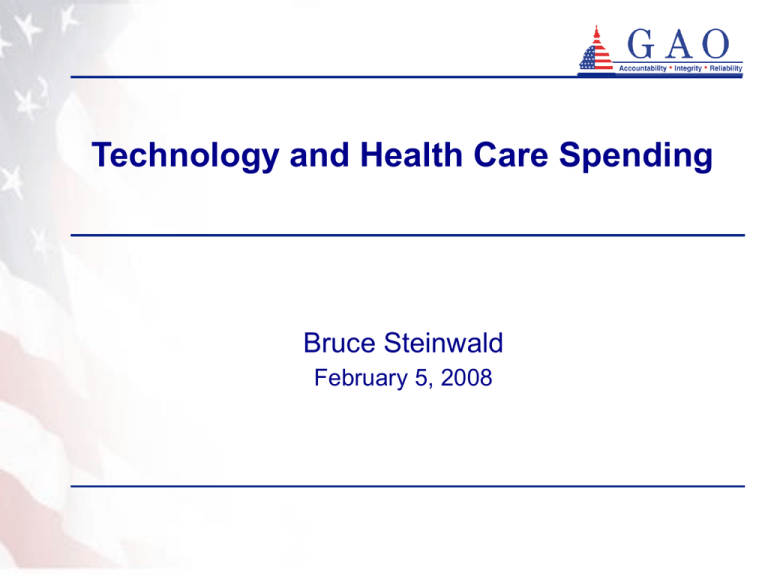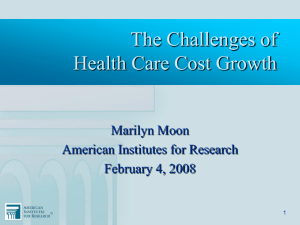Technology and Health Care Spending Bruce Steinwald February 5, 2008
advertisement

Technology and Health Care Spending Bruce Steinwald February 5, 2008 • Unsustainable Spending Trends • How does technology manifest itself in health care spending • Potential Congressional action Growth in Health Care Spending: Health Care Spending as a Percentage of GDP Percent 25 19.6 20 16.0 13.7 15 10.6 10 8.4 5 0 1976 1986 1996 Year 2006 2016 Source: The Centers for Medicare & Medicaid Services, Office of the Actuary. Notes: The figure for 2016 is projected. The most current data available on health care spending are for 2006. Effect of Entitlements on Federal Budget: Assuming Discretionary Spending Grows with GDP After 2007 and All Expiring Tax Provisions are Extended Percent of GDP 50 40 30 Revenue 20 10 0 2006 2015 2030 2040 Fiscal year Net interest Social Security Source: GAO’s January 2007 analysis. Medicare & Medicaid All other spending Cumulative Growth in Health Care Spending Per Capita, Medical Inflation, GDP Per Capita, and General Inflation, 2000-2006 50 Cumulative percentage 46.68 40 28.91 26.69 30 20 17.07 10 0 2000 2001 2002 Health care spending per capita 2003 CPI-Medical 2004 GDP per capita 2005 2006 CPI-Urban consumers Source: Bureau of Labor Statistics, The Centers for Medicare & Medicaid Services, Office of the Actuary, and the Bureau of Economic Analysis. Note: The most current data available on health care spending per capita are for 2006. Changes in Volume and Intensity of Physician Services Provided per Medicare Beneficiary, April 2000 to April 2005 Average annual percentage change in the number of services per beneficiary (volume) Average annual percentage change in the intensity of services per beneficiary, as measured in RVUs All services 4.4 5.2 Evaluation and management services 2.4 3.7 Procedures 5.7 4.3 Major -0.7 2.3 Minor 6.3 5.2 Imaging 6.9 10.5 Tests 9.1 13.9 Type of service Source: GAO analysis of Medicare Part B claims data from CMS. Differences in Services Provided by Level of Medicare Spending Percentage more services provided in highest Medicare-spending regions as compared to lowest Medicare-spending regions for select services for three chronic disease cohorts Service Type Imaging Percentage Chest radiography 60% Computed tomography (CT) or magnetic resonance imaging (MRI) of head or brain 80% CT or MRI of lumbar spine 50% Minor or Diagnostic Procedures Skin biopsy Holter monitor Diagnostic upper-GI endoscopy 120% 290% 60% Source: Elliot S. Fisher, David E. Wennberg, et. al, “The Implications of Regional Variations in Medicare Spending. Part 1: The Content, Quality, and Accessibility of Care,” Annals of Internal Medicine, vol.138, no.4 (February 2003). Diagnostic Technology Advances Subject to Multiplier Effect • Diffusion of Dx Technology leads to … • More Diseases/Conditions Diagnosed, leading to … • More Treatment, which results in … • More Spending on both Dx and Tx Sources of Information on Health Care Reform • Presidential Candidates’ Proposals • President’s 2009 Budget • Non-governmental Organizations (e.g., Commonwealth’s “Bending the Curve,” (12/2007) • Potential Congressional Actions (e.g., CHAMP, Summer 2007) Congressional Action Driven By… • Faith-Based Beliefs (e.g., IT, CE, Consumerism) • The Need to Fix Medicare’s Sustainable Growth Rate (SGR) Problem Near Term Congressional Action on Medicare • Replace SGR with Differential Fee Updates • Adjust Relative Prices in Medicare’s RBRVS • Expand Bundled Payments • Physician Profiling and Feedback Long Term: What Can We Afford? Trend: Real GDP + 2.5% … Unsustainable SGR Standard: Real GDP + 0 % … Unacceptable Medicare Trustees: Real GDP + 1% …Reasonable?





